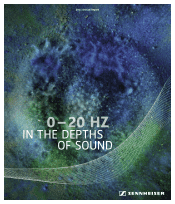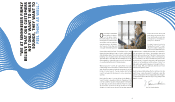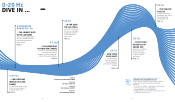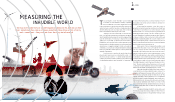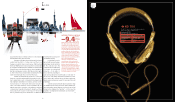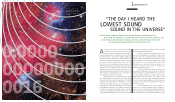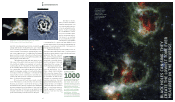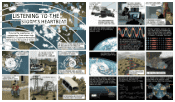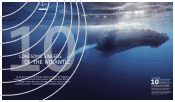Sennheiser 2011 Annual Report Download - page 8
Download and view the complete annual report
Please find page 8 of the 2011 Sennheiser annual report below. You can navigate through the pages in the report by either clicking on the pages listed below, or by using the keyword search tool below to find specific information within the annual report.
14
0.0000000000000016 Hz
BLACK-HOLE ACOUSTICS
And what is the fre-
quency of these sound waves?
A bubble that detaches only
once every ten million years or
so has an extremely low fre-
quency. To give an example,
let’s use Middle C as a refer-
ence point. A Middle C gener-
ates 262 shock waves per sec-
ond. Based on our readings,
we can conclude the tone gen-
erated by these space bubbles
is something like 57 octaves lower than Middle C. More
precisely, they produce a B-flat with the unimaginably low
frequency of 0.0000000000000016 Hz – the lowest note
ever registered in the universe.
Other than setting such outer-worldly records, our
observations have high scientific value. For instance, we are
now able to explain why gas clouds in the Perseus Cluster
remain hot. Over the course of
time, after having expended so
much X-ray radiation, gas clouds
should have cooled down. Howev-
er, with sound waves continuously
replenishing their energy, the
cloud temperature remains high.
Our findings have other
practical implications. For in-
stance, cold gas clouds should give
birth to new stars; however, this is
prevented by the heat generated
by sound waves. In other words, if
it weren’t for sound waves, there
would be many more stars and
galaxies illuminating the universe,
making the skies a lot brighter!
Sound waves help us resolve these
types of cosmological questions.
Literally speaking, it’s enough to
make you “open your eyes and
your ears.” ■
1. Chandra is the most powerful X-ray telescope of all time
2. Shock waves in the Perseus Galaxy Cluster
COSMIC EVENTS
1000
The 64-year-old Brit Andrew C. Fa-
bian has witnessed sights most
Earth-dwellers might consider in-
conceivable. A professor of astron-
omy and head of the X-Ray Astron-
omy Group at the University of
Cambridge, he has received numer-
ous scientific awards, including a
Gold Medal from the Royal Astro-
nomical Society – its highest
award. Fabian has been working in
close collaboration with NASA and
its Chandra mission for many years.
hole that constantly pulls in gas from the cloud. As the gas
plunges disk-like into the black hole, two jets of matter
shoot out in the opposite direction. The exchange can force
a part of the gas cloud outwards, creating two giant “bub-
bles,” each roughly the size of our Milky Way. The Chandra
gives us a front-row seat on the action. As the hot gas in
the cluster begins to emit a very bright X-ray radiation, the
bubbles appear as two dark circles.
The bubbles grow larger with time. After, say, ten
million years, they detach and move away from the black
hole. Just like air bubbles in an aquarium: as its aeration
system pumps air into the water, it forms bubbles that
grow, eventually detach and rise to the surface. Every time
one of these giant cosmic bubbles detaches, it acts like a
gigantic loudspeaker, sending out a spherically shaped
shock wave into the surrounding gas – a shock wave that
decays further out into sound waves. Sound, after all, is
nothing other than a pressure oscillation in a material me-
dium – of which air is but one example.
Of course we can’t hear these sounds on Earth:
most of the universe is a void and so does not carry sound.
However, we are able to record the shock waves at the
Chandra Observatory. Density is higher in areas with higher
pressure, resulting in more X-ray radiation. That’s why sat-
ellite pictures taken of black holes reveal bright circular
structures similar to the concentric ripples that form on a
pond’s surface when you throw a stone into the pond.
BLACK HOLES CAN SING. THEY
CREATE THE LOWEST TONE EVER
MEASURED IN THE UNIVERSE.
In outer space, a
powerful bass drones:
with the help of the
space telescope
Chandra, it was possible
to detect sound waves
from a supermassive
black hole
15

